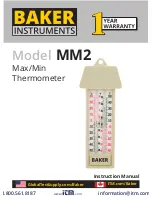
- -
31
Resistivity, TDS and salinity measurements
The HD2206.2 and HD2256.2 measure electric conductivity and temperature of a solution, and cal-
culates resistivity, salinity and TDS. By repeatedly pressing “F1 = cond.” (HD2206.2) and “F2 =
cond.” (HD2256.2) you can select the measurement.
The
resistivity
is defined as the reciprocal of conductivity. The measurement is expressed in
Ω⋅
cm
or one of the derived units (k
Ω⋅
cm, M
Ω⋅
cm or G
Ω⋅
cm). It is generally used to measure pure and ul-
tra pure water.
The
salinity
is calculated using a more complex calculation: It is based on the assumption that the
measured conductivity is entirely and only due to the sodium chloride (NaCl) dissolved in the wa-
ter. It is expressed in g/l or mg/l.
The
TDS
(Total Dissolved Solids) is the measurement of the total concentration of ion species in the
solution. It is calculated from by multiplying the conductivity measurement by a factor called “
TDS
Coefficient
”, set in the menu from 0.4 to 0.8 (MENU >> “CONDUCTIVITY MEASUREMENT
OPTIONS”
>>
“
TDS Coefficient
”). The measurement of total dissolved solids is expressed in g/l or
mg/l.
Calibration of conductivity
The probe calibration can be carried out on one to four points, using the standard solutions auto-
matically detected by the instrument (automatic calibration) or other solutions with known tempera-
ture characteristics (manual calibration).
Technical note on the instrument functioning
The instrument uses four different automatically selected measurement scales: When the cell con-
stant is equal to 1, the four standard calibration solutions are associated to a different measurement
scale. The calibration solution at 147
μ
S/cm refers to the measurement scale 0, the solution at
1413
μ
S/cm to the measurement scale 1, and so on. When the calibration point is confirmed using
the CAL key (see the details in the next paragraph), the display indicates the calibrated scale (range)
with the
;
symbol.
If the calibration was performed on multiple solutions, make sure that the
;
symbol is dis-
played near a non yet calibrated range: It is useless to calibrate the same range twice.
This warning is valid only if the cell constant is different from 1, and/or the solutions used are not
standard.
Automatic calibration of conductivity using memorized standard solutions
The instrument can recognize four standard calibration solutions:
•
0.001 Molar KCl solution (147
μ
S/cm @25°C),
•
0.01 Molar KCl solution (1413
μ
S/cm @25°C),
•
0.1 Molar KCl solution (12880
μ
S/cm @25°C),
•
1 Molar KCl solution (111800
μ
S/cm @25°C),
By using one of these solutions, the calibration is automatic; the calibration can be carried out on
multiple points to increase accuracy.
The manual calibration is possible with a different conductivity solution from that used in the auto-
matic calibration.
Summary of Contents for HD2205.2
Page 78: ...78...
















































